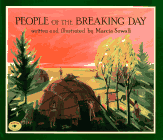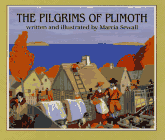Killing in Plymouth Colony, A

by Hurst, Carol Otis and Rebecca Otis. (Houghton Mifflin, 2003 ISBN 0618275975. Order Info.) Novel. Grades 4+.

Review

Okay, another shameless promotion this month. We're highlighting a book we wrote together that's just been released. We know we're prejudiced, but we think it's something many of you can use. It's about the Pilgrims and that's timely, but it takes place in 1630. That's nine years after the first Thanksgiving which is when most teachers take down the bulletin boards with all those people wearing buckles on their hats and shoes (which it turns out they didn't wear), and drop the subject leaving kids with the impression that the Pilgrims ate dinner and faded away.
We wrote A Killing in Plymouth Colony to dispel misinformation, but we also wrote it because of a strange genealogical connection to our family. Several of our ancestors were part of Plymouth Colony. That's only mildly interesting. The really interesting thing is that one of those ancestors was William Bradford, the second governor of the colony and, by most accounts, a fine upstanding citizen. From the other side of our family, however, are the Billingtons, also passengers on the Mayflower and citizens of Plymouth. Their reputation is far less honorable. John Billington, in fact, was a troublemaker and a murderer. We won't even discuss what that means about our genes.
Add to that intriguing clash the fact that Rebecca worked for a year in the living historical museum of Plimoth Plantation and knows a lot about the colony and was willing to learn more, and that Carol has been creating some historical fiction for young readers, and you have A Killing in Plymouth Colony. While we wanted to talk about the colony and why it existed and what life within it was like, we also wanted to bring it down to a personal level. We used real people and, as much as possible, actual events in history while filling in the considerable gaps with our imagination. A Killing in Plymouth Colony is about a relationship between a boy and his father. The boy is John Bradford, eleven years old at the time of this novel, and the son of Governor William Bradford. In the small colony of Plymouth where everybody knows all about everybody, it can't have been easy to be the child of the governor. John and his father are almost strangers to each other, partly because John did not come over with his mother and father. Only a year old in 1620, he was left behind with a family in Holland for the first eight years. John's birth mother, Dorothy, died while the Mayflower lay at anchor in Cape Cod Bay. Governor Bradford sent for Alice Carpenter to come from Holland to be his second wife many years before he sent for John. John's many attempts to reach out to his father fail time after time. The governor's attention is focused on the colony. There's one collision point.
John, like many young people, has a strong sense of fairness. He thinks Master John Billington is being treated unfairly by his father and by other leaders of the community. When one of the colonists is murdered and his father's suspicion falls on Billington, things between John and his father reach a flash point. Then, of course, there's five-year-old Rachel Eaton. Master Billington helped heal her pet crow's wing and Rachel's love and gratitude are palpable. The background for all this, of course, is life in the tiny colony where many people live in each tiny house and work tirelessly to survive. They are not the dour, drab people portrayed in many history books. They danced, sang, gossiped, feared, loved and hated. Some things haven't changed much.
You can read the first few chapters of this book on Google Books at http://books.google.com/books?id=rq1rgcUpuzoC&printsec=frontcover&dq=rebecca+otis

Things to Talk About and Notice
- An amazing number of people live in the tiny Bradford house. How do they manage to do that?
- John works hard most days and so does his stepmother. What does the governor do all day?
- If you could talk to John and his father at about the middle of the story, what would you say to them? Would anything help them understand each other?
- Notice the ways in which John tries to get his father's respect or admiration.
- Notice the ambivalence the characters have about dealing with witchcraft.
- Why does Rachel stop talking?

Activities
- Find the best word to describe each of the characters in the book.
- The early Pilgrims built their houses using wattle and daub. Build wattle and daub models with clay, sand, and straw plastered on stick forms. It will crack, but so did the wattle and daub.
-
Alice tells John a little about his father's childhood. Find out more. How did William Bradford come to be governor? How long did he serve?
- The people in Plymouth are anxious to have their children learn to read and write. Find out about the rate of adult literacy in Plymouth and in other colonies.
- Find examples of words and expressions that were part of early American English. What words do we use today instead of those early words? Find some words that are currently in the process of change.
- The Pilgrims drew up the Mayflower Compact as a constitution. Compare the individual rights issues in the Mayflower Compact to those in the US Constitution. Create a constitution for your classroom. How does it compare with the Pilgrims' constitution?
- Investigate capital punishment in the colonies.
- Find out what happened in later years to Plymouth Colony.
- Visit Plimoth Plantation or view videos about it.
 How did Native Americans and Pilgrims interact? How are two cultures interacting in your area? Use Marcia Sewall's two books on the same area, People of the Breaking Day and The Pilgrims of Plimoth, for information on the two cultures.
How did Native Americans and Pilgrims interact? How are two cultures interacting in your area? Use Marcia Sewall's two books on the same area, People of the Breaking Day and The Pilgrims of Plimoth, for information on the two cultures.
- The book refers briefly to the Oldham rebellion. Find out more about it. Who rebelled? Over what? How was the rebellion put down?
- Look up and read the treaties between the Pilgrims and the Indians. How long did they keep to the provisions of the treaties? When were they broken? What was the result?

Related Books
- * * * Grades 3 and up
Bowen, Gary. Stranded at Plimoth Plantation 1626 (HarperTrophy, 1998 ISBN 0064407195. Order Info.)
This is a good resource for information about daily life in early Plymouth. We see it from the point of view of an indentured servant who was bound for Virginia when the ship was driven north to Plymouth. By this time the colony was fairly well established and the young boy adapts to the work and the customs there. - * * Grades 5 and up
Clapp, Patricia. Constance: A Story of Early Plymouth (HarperTrophy, 1991 ISBN 0688109764. Order Info.)
Told in journal form, we get the story of a young girl from the time she arrives on the Mayflower to her wedding day five years later. - * * * Grades 4 and up
Bradford, William. Homes in the Wilderness: A Pilgrim's Journal of Plymouth Plantation in 1620 (Linnet, 1988 ISBN 0208022694. Order Info.)
William Bradford's original journal has been abridged and translated into modern English for younger readers. It is an excellent almost primary resource. - * * Grades 3 and up
Penner, Lucille. Eating the Plates:A Pilgrim Book of Food and Manners (Simon & Schuster, 1991 ISBN 0027709019. Order Info.)
This interesting book shows the evolution of foods -- the storage, preparation and consuming -- in the early American diet starting with that of the Pilgrims. - * * Grades 3 and up
Roop, Connie. Pilgrim Voices: Our First Year in the New World Illustrated by Shelley Pritchett (Walker, 1998 ISBN 0802775306. Order Info.)
Using some excerpts from Mourt's Relation and Bradford's journal combined with fictionalized text, the book tells of the Pilgrim's first year. - * * * Grades 2 and up
Sewall, Marcia. People of the Breaking Day (Atheneum, 1990 ISBN 0689314078. Order Info.)
A member of the Wampanoag tribe, who occupied the area that became Plymouth, tells of the ceremonies and customs that mark the passages of life of these people who lived in harmony with nature under the guidance and wisdom of Massasoit.  * * * Grades 2 and up
* * * Grades 2 and up
Sewall, Marcia. The Pilgrims of Plimoth: Struggle for Survival (Aladdin, 1996 ISBN 0689808615. Order Info.)
This beautiful picture book gives us a historically accurate look at the life of the Pilgrims in about 1630. Told from the points of view of several Pilgrims, the book does much to erase many of the misconceptions about those early settlers.- * * * Grades 2 and up
Sewall, Marcia. Thunder from the Clear Sky (Aladdin, 1998 ISBN 068982176X. Order Info.)
Sewall's earlier books listed above lay the groundwork for this one in which the two cultures clash. After the deaths of Massasoit and William Bradford, relations between the Indians and the settlers broke down as treaties were broken and war ensued.

Related Areas Within Carol Hurst's Children's Literature Web Site
- The Time of the Pilgrims: 1600-1700. Featured Subject with activities, related books and links.
- US History. Links to articles on many different topics with activities, related books and links:
http://www.carolhurst.com/subjects/ushistory/ushistory.html - Colonial America. Featured Subject with activities, related books and links:
http://www.carolhurst.com/subjects/ushistory/colonial.html - In Plain Sight by Carol Otis Hurst. Featured Book with activities, related books and links:
http://www.carolhurst.com/titles/inplainsight.html

Related Areas Elsewhere on the Internet
Following these links will take you off our web site. You will have to use your back button to return or, bookmark our site now so you can return anytime.
- Plimoth Plantation Living Museum:
http://www.plimoth.org - The Pilgrim Society:
http://www.pilgrimhall.org/ - Bradford's Of Plymouth Plantation online text:
http://members.aol.com/calebj/bradford_journal.html - Search the Plymouth Archives University of Virginia
http://etext.lib.virginia.edu/users/deetz/Plymouth/searchform.html
Advertisement:
Advertisement:
Advertisement:

